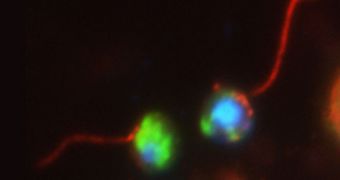In a recent scientific investigation, experts managed to identify the oldest and most peculiar group of fungi ever studies. The microorganisms can apparently live without being surrounded by a rigid cell wall, and they are very good at camouflaging themselves.
Even on some of the most advanced microscopes today, the fungi appear as very tiny dots, some of which has a skinny, tail-like appendage. For all intents and purposes, these organisms live as naked cells, as far as experts van tell.
Usually, a fungus is defined by the fact that it surrounds itself with a rigid cell wall, but this appears not to be the case with the new class of organisms, which researchers dubbed cryptomycota.
The recent discovery was made by a team of scientists in the United Kingdom, who were led by expert Tom Richards. The investigator holds joint appointments with the Natural History Museum, in London, and the University of Exeter, Science News reports.
Thus far, his team only managed to observe the new fungi at two life stages. In one of them, the cells are in a swimming form, while in another they are affixed to algal cells, in a symbiotic relationship.
None of these stages revealed the existence of a chitin-based layer coating the cells, which is common for this type of microorganisms. Details of the new work appear in the May 11 online issue of the top journal Nature.
“People are going to be excited. The question is, is there another stage in the life cycle that does have cell walls?” comments University of Michigan in Ann Arbor mycologist Tim James. He is also involved in studying ancient fungal groups.
Rochards and his team also conducted a DNA analysis of the organisms, and determined that they are a part of the same group as a known genus called Rozella. Similar to other types of fungi, the newly-discovered one is very difficult to grow in the lab.
In-depth DNA sequencing analysis of this fungal group revealed that it “just got bigger and bigger [in genetic diversity] until it was as big as all previously known fungi,” the team leader goes on to explain.
“The big message here is that most fungi and most fungal diversity reside in fungi that have neither been collected nor cultivated,” argues University of California in Berkeley (UCB) expert John W. Taylor.
The new discovery already elicited some debate in the international scientific community, between those who say that these organisms are fungi – and that therefore a reclassification of these microorganisms is in order – and those who believe that they are a different class of organisms.

 14 DAY TRIAL //
14 DAY TRIAL //